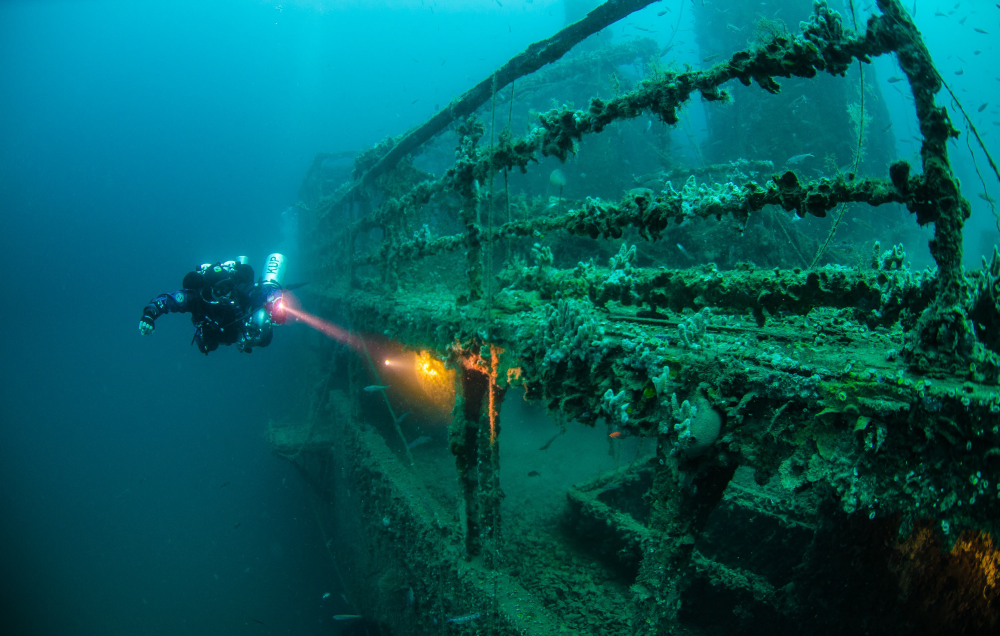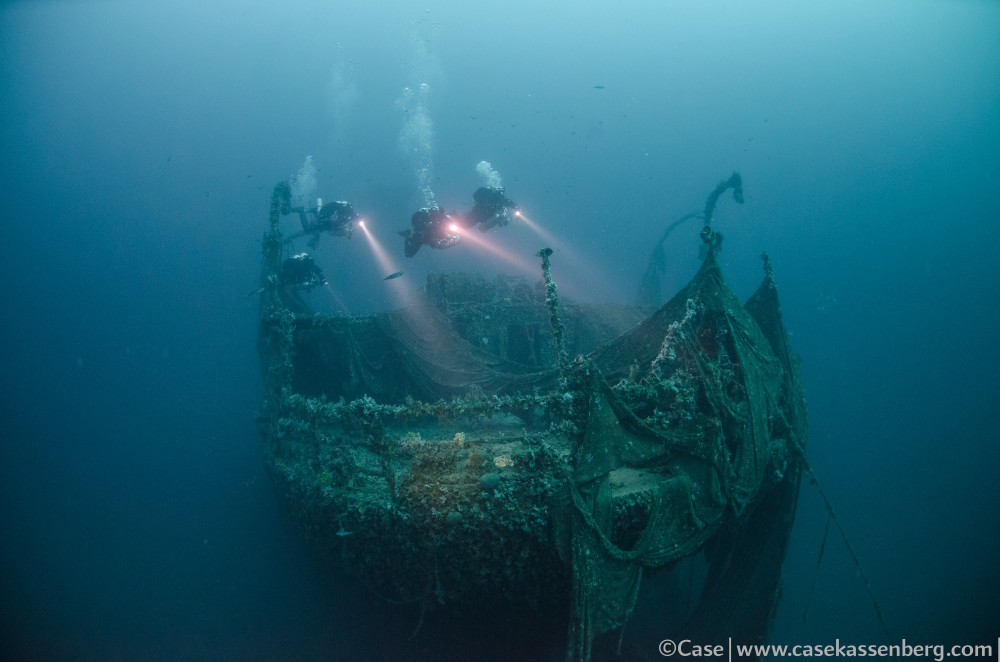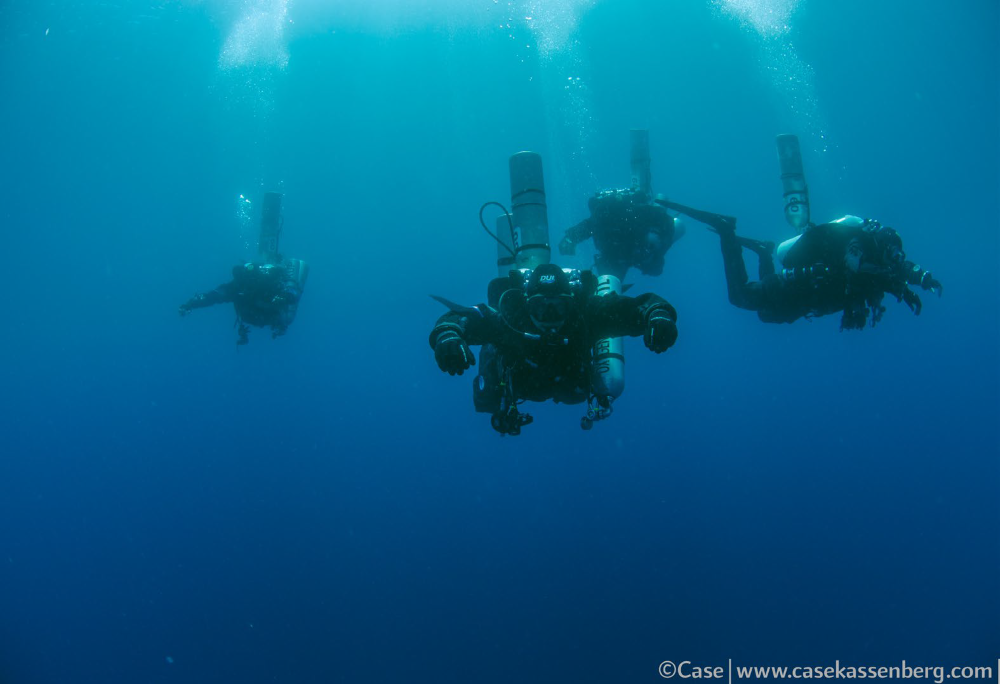
VIS Wreck in Croatia – Depth of about 60 m / 195 ft
It’s early in the morning when we arrive at the dive shop. Maurizio from Krnica dive has all our tanks set up and ready for us to analyze the breathing gases. Gas analysis stickers are approved and signed and tank pressure are double-checked. As always everything is spot on and we prepare the dive sets for the first dive while we are still on the shore.
For this trip we received several Suunto full-trimix computers to test : two DX and two HelO2 wrist size computers. The HelO2 works with Technical RGBM and the DX runs on the new “fused” RGBM. We are asked by Suunto Netherlands to compare the two algorithms with our “normal” ratio decompression as well as to write an article about the overall “workability” of these watches.
For the comparison we need data and for data we need to log dives, so first things first. The main goal of today’s dive is to create as many photo opportunities as possible. Our photographer Case gives an extensive briefing on how and where he wants us to hover near the wreck. It’s all clear and we are eager to do the dive.
It’s pretty warm on the boat in our dry suits under the Croatian sun, so once we hit the water it feels great. We do the bubble check, gather at the shot line, switch to the bottom stage and start the descent. According to the dive plan we will be at the superstructure at 150 ft within three minutes. At 90 ft we can already see the outline of the ship. We leave the line and fin our way to the superstructure. No matter how many times you’ve been diving this ship, it remains one of the most beautiful wrecks in the Adriatic. Unlike many of the other wrecks that have sunk during WWII the Vis wreck is in upright position on the seabed and looks like it literally just steamed around the corner. Normally the Vis is surrounded by a milky fluid caused by the limestone in the surrounding mountains, but today we are spoiled with sublime visibility. I mumble WOW into my second stage. The helium in my breathing gas deforms my voice and Jeroen looks at me quizzically to find out if something is wrong. Good: the team-awareness is fine. I signal that I am more than okay . We proceed with our descent.
At the superstructure we check our gauges and start the actual dive. We made our gas calculations quite conservative. At this depth, we have about 15 minutes on our bottom stage, so plenty of time before we have to switch to backgas. We descend into the hatch of the first cargo hole and at make our way through a beautiful overhead corridor in between the first and second deck. It is low and narrow but not too complicated. Just before it gets really dark you can see the light coming through the hatch of the second part of the ship. Jeroen fins into the corridor first, followed by Case. One after another we calmly fin our way to the second cargo hole at 185 ft. It is one of those dives where I feel I have full control. This is what we do it for. This is what we train for. In the darkest part of the corridor I check the screens of the DX and the HelO2. It is dark so I need the backlight to read the info on the screens. I find the button intuitively and the info can be read perfectly. The gentle movements of Case in front of me and the steady beam of Richard behind me, are making me feel really comfortable. Gosh, this is a great team to dive with.
Although I know that I have not hit anything with my manifold, when we come out of the corridor I do a quick flow check. This is the type of dive where it is nice to be sure that your valves are fully opened. Meanwhile my attention is drawn by Jeroen who’s beam is focused on the beautiful auxiliary propeller. Again, I cannot suppress a WOW. Of course Richard can’t hear what I say but fully understands and winks at me…

Exploring the VIS Wreck
We ascend from the second cargo hole and continue our way to the back deck. The wreck is overgrown with coral and although there are a few decaying fishing nets hanging around, the shapes are unmistakable and beautiful. The boys and girls of Ghost Fishing will have a different opinion but for me the nets are part of the mystique of this lovely lady.
Case planned to shoot a few pictures in this area and Jeroen has chosen a beautiful spot for the gas switch from bottom stage to back gas: in the lee area of the deck. I have a look around and enjoy the scenery. Could have been in a worse place team captain…
Our way back leads us along the statue like chimney and an open corridor on the upper deck. Jeroen and Richard enter the corridor, Case and I follow outside for a photo. Last year he took a pretty bizarre picture of Richard in the wheelhouse. We ascend a bit to see if this photo could possibly be surpassed. Richard hangs in his tightest trim and shortly thereafter Case makes his characteristic “Case-is-finished-with-his-picture” gesture high above his head: we can continue. We swim an extra circuit around the wheelhouse and slowly all the way back to the bow.
Case has not yet been able to shoot a good picture of the bow of the Vis and has meticulously briefed us about the shot that he has in mind. Richard and I are the background extras in the shot of Jeroen with the Suunto DX hanging around his wrist. We hover dutifully and hope the pictures are just as Case has in mind.
We gather at the shot line and start the long ascent. Richard is the deco-captain and he will be in control of the deco from 90 ft. Next to his bottom timer Richard has one of the Suunto HelO2’s on his wrist to test. According to his own words, his eyes are not getting worse but his arms are getting shorter every year so the “big screen display” is a godsend for him.
I’m having an easy one this dive. It is my task to shoot the buoy if necessary but as expected : no need for that. I therefore have little to do during deco and can have a good look at the Suunto DX (fused RGBM) and a HelO2 (tech RGBM) on my wrist so that we can compare the different algorithms.
At 70 ft. we all do our gas switch to 50%. After we are all comfortable and stable, Richard and I make the gas switch on both the DX and the HelO2 to the new gas mix. Both work very intuitively. We are all familiar with the menus and the operation of Suunto, so with a few touches of the buttons all our computers are “switched”.
During the ascent from 70 to 20 ft each of us does his bottle rotation so the empty and positively buoyant bottom stage is out of harm’s way on the leash on our butt-D ring and the 40 cuft stage bottle with 100% oxygen is ready to use. The last minute of our 30 ft stop we do a gas break and switch to back gas in preparation for the long stop at 20 feet at 100%.
Team captain Jeroen sometimes has some headaches with the switch to pure oxygen but luckily this time it’s no problem at all. Smoothly we all switch to the gas-of-the-gods and at least as smooth all the computers are in mix: 3.
Than: it’s hangtime. Each teammember has his own way to pass the time at 20 ft. Jeroen to our knowledge, the only man able to go into some sort of cryo sleep at this depth. Case takes advantage of the natural light and mostly manages to shoot some brilliant pictures. Richard is routinely evaluating the dive in his wet notes, and me? In my head I was busy writing this article.
Hope to see you at the waterfront and don’t forget to like and follow Team Pitch Blue on Facebook!
WORDS by Job Kuperus and PICTURES by Case Kassenberg

TEAM PITCH BLUE at VIS Wreck

















